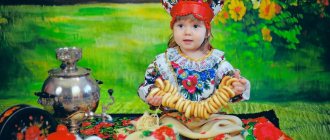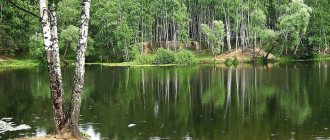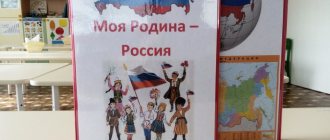Development and presentation for National Unity Day “Revived Holiday”
Conversation with elements of frontal questioning
"Revived holiday"
Target. Cultivate an interest in studying the history of your country, a sense of pride and respect for the defenders of the state.
Tasks:
-introduce students to the history, meaning and significance of the national holiday;
- give an idea of the events of the early 17th century;
- contribute to the education of patriotic feelings, a sense of pride for the Motherland;
Equipment: multimedia projector, screen, Pover Point presentation.
Slide 1
On November 4, Russia celebrates National Unity Day.
Our task is to find out why the holiday is “revived”.
Slide 2
National Unity Day was established in December 2004 by Russian President Vladimir Putin in memory of the events of 1612, when the people's militia led by Kuzma Minin and Dmitry Pozharsky liberated Moscow from the Polish-Lithuanian occupiers.
This is the youngest public holiday
was celebrated for the first time in Russia on November 4, 2005.
This is a revived holiday
having its own centuries-old history.
Slide 3.
Historically, this holiday is associated with the end of the Time of Troubles in Russia in the 17th century. V
Troubles,
The Time of Troubles is the name of the tragic period in the history of our fatherland from 1598 to 1613. Chronologically, this period can be designated as 1584 - 1613. After the death of Tsar Ivan IV the Terrible in 1584, his heir Fyodor Ioannovich ascended the throne, who showed little interest in state affairs. Tsar Fedor had no heirs, and his only successor, Tsarevich Dmitry, died in Uglich as a child. In 1598, Fyodor Ioannovich died, and the royal Rurik dynasty ended with him.
15 years in the history of Russia included so many events that in the history of any other state they would have been more than enough for a good hundred years: V - three kings - Boris Godunov (1598–1605), False Dmitry I (1605–1606) and Vasily Shuisky (1606–1610); Seven Boyars;
V
Slide 4-5.
Boyar conspiracies and intrigues, V
terrible famine (1601 - 1603),
drought, plague epidemic.
V
Slide 6-8
Cossack, Polish and simple bandits were rampaging everywhere, mocking Russian people with impunity, robbing, killing, mocking shrines. Fires and violence started.
The Polish lords took advantage of the terrible situation, trying to enslave Rus'. In their insidious plans they used impostors False Dmitry I and False Dmitry II, who acted under the name of Tsarevich Dmitry.
Slide 9
Today it is difficult for us to imagine what the Russian people had to endure then. Here are just three historical facts of the Polish intervention: – The siege of the Trinity-Sergius Monastery lasted 16 months (from September 1608 to January 1610). 15 thousand Poles could not break the spirit of two and a half (!) thousand Russians, of whom only every tenth remained alive by the last assault on July 31, 1609;
Slide 10
V 11
- in September 1609, the Polish king Sigismund besieged Smolensk. The city held out steadfastly for
20 months, although due to terrible scurvy (there was just no salt!) its population decreased by 9 times; Open Polish intervention began. V - in March 1611, the Poles burned Moscow to Kitay-Gorod and the Kremlin, where they took refuge themselves.
There were about 60 thousand killed and burned Muscovites. “..everything threatened the Russian land with inevitable destruction”...
Slide 12
And there would have been destruction if not for the faith and patriotism of the Russian people. Throughout the Russian land, indignation grew against the Poles and their dashing people.
Nizhny Novgorod took over the banner of the liberation struggle.
At a meeting of elected people who had gathered to talk about the disasters of the earth, the zemstvo elder and merchant Kozma Zakharyich Minin-Sukhoruk rose from his place. Nizhny Novgorod residents knew him as an active and practical person. At a city meeting, Kuzma Minin made his famous speech: “Orthodox, let us help the Moscow state, we will not spare our bellies, and not just our bellies - we will sell our yards, we will pawn our wives and children. It's a great thing! But God will help us." The next day, a sacrificial impulse swept the entire city. People gave their last.
Slide 13
To lead the militia, Nizhny Novgorod residents decided to call upon the prince and governor, 30-year-old Novgorod prince Dmitry Mikhailovich Pozharsky, who was being treated nearby after being wounded, and sent delegations of Nizhny Novgorod townspeople to him for negotiations.
Pozharsky agreed, but on one condition: the treasury of the militia must have a special person with exceptional powers. This person was Kuzma Minin.
Kuzma Minin began to manage the militia treasury.
Slide 14
So these two people, elected by the people, became the heads of the Nizhny Novgorod militia. From that time on, Pozharsky and Minin began to represent the only legitimate power in the Moscow state.
Slide 15
At the beginning of March 1611, the Nizhny Novgorod militia set out on a campaign. He was hurried by both time and the coming spring, which threatened the road with mud.
Slide 16
The Polish occupiers had their last refuge - the Kremlin, which came under a strong siege.
Slide 17
In August 1612 Militia detachments defeated the Polish army near the capital. October 22 / November 4, 1612
militia fighters led by Minin and Pozharsky took Kitay-Gorod by storm.
Slide18-19-20
With the militia, which was led by Kuzma Minin and Prince Dmitry Pozharsky, was the miraculous icon of the Mother of God of Kazan. The Most Holy Lady took the militia under Her protection, and Russia was saved through Her intercession. Before the decisive battle, the Orthodox army endured a three-day fast and tearfully prayed to the Queen of Heaven in front of Her Kazan Icon for the granting of victory. The icon became the main shrine of the militia, a kind of battle banner.
On Sunday, October 25, Russian squads solemnly, with a procession of the cross, went to the Kremlin, carrying the Kazan Icon. The Poles, besieged in the Kremlin, exhausted by hunger and having lost hope of outside help, were forced to surrender. The command of the interventionist garrison signed the surrender. This day became a day of national celebration.
Slide 21
The confidence that it was thanks to the icon of the Kazan Mother of God that the victory was won was so deep that Prince Pozharsky, with his own money, specially built the Kazan Cathedral on the edge of Red Square. Amazingly beautiful, it is decorated with a large mosaic icon of the Kazan Mother of God. Above the entrance is an icon of the Savior.
Slide 22
By decree of Tsar Alexei Mikhailovich, who reigned in 1645-1676, the obligatory celebration of November 4 was established in 1649 as a day of gratitude to the Blessed Virgin Mary for her help in liberating Russia from the Poles (celebrated until 1917). This day was included in the church calendar as the Celebration of the Kazan Icon of the Mother of God in memory of the deliverance of Moscow and Russia from the Poles in 1612.
In 2004, the holiday was approved as National Unity Day by President V.V. Putin Thus, National Unity Day is essentially not a new holiday at all, but a return to the old tradition.
On National Unity Day, in different cities of our country, political parties and social movements organize rallies, processions and concerts, charity events and sporting events.
Slide 23 -24
Heroes and heroes in Rus', it seemed, had already disappeared. But there were two honest people who timidly and even seemingly reluctantly emerged from the faceless mass of Russian people - and only then, after their unparalleled feat, went back into the shadows. These two - a Russian peasant and a Russian service man - showed a rare example of selfless service to the fatherland. Therefore, it is no coincidence that their descendants, and only their image, decided to decorate Red Square.
Slide 25
A copy of the monument in Nizhny Novgorod. And in other cities of our country
Slide 26
The merits of Minin and Pozharsky were highly appreciated by the new autocrat: Pozharsky was granted a boyar, and Minin - a Duma nobleman (an act unprecedented at that time).
In the new Moscow government, Minin was entrusted with collecting treasury from all cities. He performed this work until his early death in 1616.
Prince Dmitry Pozharsky successfully led troops in battles against the Polish invaders. Since 1619 he actively worked in the Russian government, heading a number of Orders. Dmitry Pozharsky died on April 30, 1642.
Kuzma Minin and Dmitry Pozharsky are among the most revered Russian national heroes.
Slide 27
Summary of the conversation. This historical page of our Fatherland has once again shown that in difficult times for the country, Russian people’s patriotic feelings are especially clearly manifested and their best qualities are revealed: selfless love for the Fatherland, the greatest valor and heroism,
the ability to withstand the most difficult trials and defend one’s independence.
Additional Help
Monument to Minin and Pozharsky
the work of the sculptor I. P. Martos (1752 - 1835) is one of the most famous monuments in Moscow. It was created from 1804 to 1815. on public donations and was installed on February 20, 1918 (old style) on Red Square opposite the entrance to the Upper Trading Rows.
The sculptor depicts the moment when Kuzma Minin, pointing his hand towards Moscow, hands Prince Pozharsky an ancient sword and calls on him to stand at the head of the Russian army. Leaning on the shield, the wounded governor rises from his bed, which symbolizes the awakening of national self-awareness in a difficult hour for the Fatherland. On the pedestal of the monument, decorated with two bas-reliefs, there is an inscription: “To Prince Pozharsky and citizen Minin, grateful Russia. 1818"
.
In 1930, it was decided to move the sculpture so that it would not interfere with parades. From this time to the present day, the first monument in Moscow is located at the Intercession Cathedral (St. Basil's Cathedral).
Kazan Cathedral
, consecrated in honor of the Kazan Icon of the Mother of God, was built in the 20s of the 17th century at the expense of Prince Dmitry Mikhailovich Pozharsky in gratitude for his help and intercession in the fight against the Polish-Lithuanian invaders. The wooden Temple was consecrated by the Patriarch in the presence of the Tsar and Prince Pozharsky himself, who brought the revered icon of the Kazan Mother of God from the Church of the Presentation, where it was kept until the construction of the Kazan Cathedral.
A few years later, the Temple was seriously damaged by a fire and was restored from brick by the architects Glebov and Petrov in 1635-1637 by order of Tsar Mikhail Fedorovich. After the revolution, the Cathedral, like many other Temples, was destroyed. At first it was closed and turned into a canteen and warehouse, and in the summer of 1936 it was demolished, thus marking its three hundredth anniversary. Fortunately, the architect P. Baranovsky, carrying out the restoration in 1920, managed to make drawings and measurements. By decision of the Moscow government, the Kazan Cathedral on Red Square was restored according to the design of O. Zhurin, a student of P. Baranovsky.
Internet sources: RIA Novosti https://ria.ru/society/20081104/154357573.html#ixzz2hnv23MjX
encyclopedia.mil.ru
https://ru.wikipedia.org/wiki
https://encyclopedia.mil.ru/encyclopedia/history/ [email protected]
https://www.rodgaz.ru/index.php?action=Articles&dirid=79&issue=351&tek=24414
www.kazaki-narod.ru
https://famouspeople.ucoz.ru/news/4_nojabrja_1612_goda_osvobozhdenie_moskvy_ot_poljakov
https://pro100-mica.livejournal.com/63696.html





